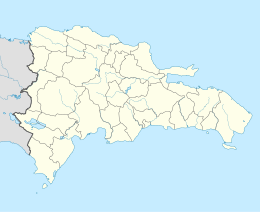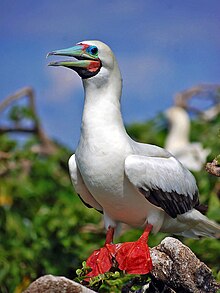| Native name: Isla Saona | |
|---|---|
 Saona Island Saona Island | |
 | |
| Geography | |
| Location | Caribbean Sea |
| Coordinates | 18°09′20″N 68°41′58″W / 18.15556°N 68.69944°W / 18.15556; -68.69944 |
| Area | 110 km (42 sq mi) |
| Length | 25 km (15.5 mi) |
| Width | 5 km (3.1 mi) |
| Coastline | 47 km (29.2 mi) |
| Highest elevation | 35 m (115 ft) |
| Administration | |
| Province | La Romana |
| Demographics | |
| Population | 300 |
| Pop. density | 2.73/km (7.07/sq mi) |
Saona Island (Spanish: Isla Saona) is a 110-square-kilometer (42 sq mi) tropical island located off 1.5 miles (2.4 km) off the south-east coast in Dominican Republic's La Altagracia province. It is a government-protected nature reserve and is part of Cotubanamá National Park. There are two permanent settlements, the town of Mano Juan and the naval base at Catuano. The island is a popular tourist destination in the Dominican Republic.
Etymology
Granberry and Vescelius (2004) suggest a Macoris etymology for the name Saona, comparing it with sa-ona 'full of bats' in the purportedly related Warao language of the Orinoco Delta.; However, it is widely accepted that Christopher Columbus named it after the Italian city of Savona.
History
Saona has pre-Columbian pictographs and petroglyphs found at Cueva de Cotubanamá. The island was known as "Adamanay" by the indigenous Taino. The island was baptized "Saona" by Christopher Columbus, who landed on it in May 1494 during his second voyage to the Americas. Columbus named Michele da Cuneo the first governor of the island. The name was meant "... to honor Michele da Cuneo, friend from Savona." By 1500, the Tainos on the island provided Santo Domingo with most of its cassava.
The island is the site of a series of shipwrecks dating back to the early Spanish control of the island. At least three vessels wrecked on the island due to storm, or piracy.
Saona did not have permanent inhabitants until 1944, when the first buildings were constructed on the island. Since then a village was established at Mano Juan which has homes for the local fishermen along with boutique hotels.
Geography
Saona Island is located 1.5 miles (2.4 km) off the coast of peninsula that comprises the mainland section of the Cotubanamá National Park. The island itself is 110-square-kilometer (42 sq mi) and is surrounded by the Caribbean Sea, with sandbars, and a number of coral reef ecosystems with a wide marine diversity. The island itself is covered in white sand. The northern coast of the island is more rugged, while the southern and western coasts hold the best open beaches on the island. The island has multiple lagoons including the larger Secucho lagoon located inland and the Canto de la Playa and Las Flamencos lagoons on the southern part of the island.
Flora and fauna

Of the 539 registered species of endemic flora within the Cotubanamá National Park, most of them are found in the diversity of ecosystems on Saona including wild bushes and mangroves, semi-humid and salted forests. Four species of neotropical mangrove are present along the Catuano Channel - red, white, black, and button mangle. The island also has large palm forests and lowland rainforest.
112 species of birds are found on the island, including brown pelicans, magnificent frigatebirds, flamingos, gulls, endemic Hispaniolan parrots, and red-footed boobies.
Saona is the Dominican Republic's most important site for sea turtle nesting. The site is threatened by climate change and coastal flooding. In the surrounding Caribbean Sea, 40 species of fish, 10 coral, and 124 mollusks can be found, with other marine life including green sea turtles, loggerhead sea turtles, manatees, bottlenose dolphins, rhinoceros iguanas, and octopuses.
Municipalities
There are two permanent settlements, the towns of Mano Juan and Catuano. Mano Juan is the only inhabited village on the island. Catuano is the site of a naval base. The island is powered entirely by renewable energy produced by a solar power plant that provides electricity to the 600 residents of the island.
Economy
Saona Island is one of the key tourist locations in the Dominican Republic with over 1 million visitors per year. It is the most visited protected area in the Dominican Republic, capturing 45% of the visits to protected areas in 2019.
A secondary economy is based around film production. Films such as Pirates of the Caribbean: The Curse of the Black Pearl (2003) and The Blue Lagoon have been filmed in part on Saona Island.
See also
References
- "Ley 5597 de 1962 que modifica la ley 5220 de 1959" (PDF).
- Granberry, Julian; Vescelius, Gary (2004). Languages of the Pre-Columbian Antilles. Tuscaloosa, Alabama: University of Alabama Press. ISBN 0-8173-5123-X.
- ^ Taviani, Paolo Emilio (1991). Columbus the Great Adventure. New York: Orion Books. p. 185.
- ^ Dominican Republic's Tourist Destinations Report (PDF) (Report). Punta Cana: Ministerio de Turismo. April 2021. Archived (PDF) from the original on 2022-07-09.
- ^ "Saona Island: a genuine Caribbean paradise". barcelo.com. Retrieved 27 November 2024.
- "Saona Island". Bayahibe Village. Retrieved 2022-08-13.
- Fernández-Armesto, Felipe (1991). Columbus. Oxford, United Kingdom: Oxford University Press. pp. 103–104.
- Floyd, Troy (1973). The Columbus Dynasty in the Caribbean, 1492-1526. Albuquerque, New Mexico: University of New Mexico Press. p. 57.
- Marx, Robert F. (1987). Shipwrecks in the Americas. New York City: Dover Publications. pp. 368, 370, 374. ISBN 0-486-25514-X.
- ^ Taylor, Lauren (July 3, 2024). "How to holiday like a celebrity in the Dominican Republic's secret unspoilt island Saona". Irish News. Retrieved November 27, 2024.
- "Saona Island – Complete Travel Guide 2022". Lopesan Costa Bávaro. Retrieved 27 November 2024.
- ^ "Saona Island, a paradisiacal place!". Visita Dominicana. Retrieved 27 November 2024.
- Jacobo, Julia (20 April 2023). "Sea level rise could wash away turtle breeding grounds around the world, researchers say". ABC News. Retrieved 27 November 2024.
- "U.S. plans to build a US$1.5 M naval base in Saona island". Dominican Today. 18 February 2012. Retrieved 27 November 2024.
- "Saona Island already works 100% with renewable energy". Dominican Today. 5 January 2023. Retrieved 27 November 2024.
- Hosteltur. "Gobierno dominicano anticipa un plan para relanzar Bayahíbe | Economía". Hosteltur: Toda la información de turismo (in European Spanish). Retrieved 2022-03-18.
External links
 Media related to Saona Island at Wikimedia Commons
Media related to Saona Island at Wikimedia Commons
 Panoramic view of Saona Island
Categories:
Panoramic view of Saona Island
Categories: